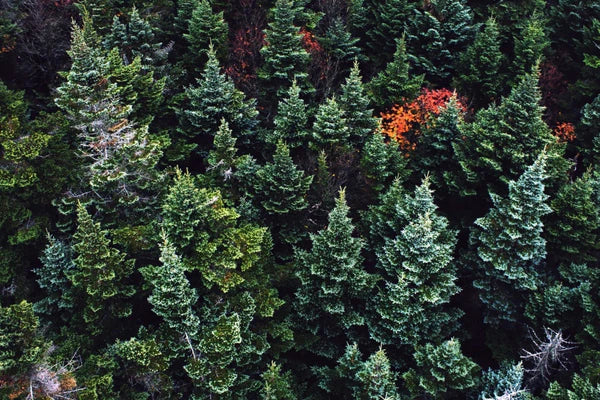What are evergreens? For starters, evergreen trees typically have foliage year-round unlike deciduous trees that shed all their leaves annually. The term evergreen means that trees will keep growing leaves as other leaves fall off. For that reason, most people think of Pines and Christmas Trees when they think of the word evergreen. However, any tree that keeps its green foliage year-round, enduring the cold weather and dry seasons or hot, humid temperatures, is an evergreen.
And needless to say, there's a ton of options. Our guide below explains how to choose the right evergreen trees for your yard, so keep reading to learn more!
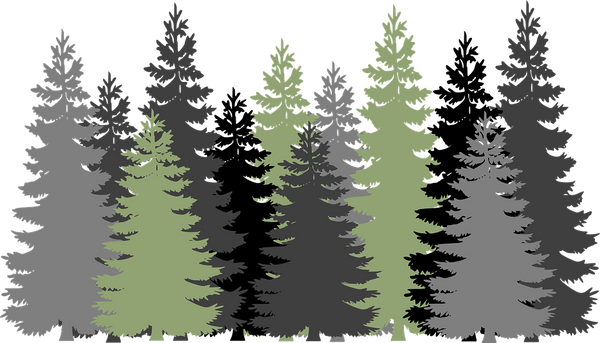
What are the Best Evergreen Trees for Privacy?
First, we recommend that you determine the purpose of trees for your landscape. Will your evergreen trees be used for windbreaks, screening and privacy, or will they be decorative trees? Evergreens come in many different shapes, sizes, colors and leaf types. Knowing the purpose of these trees will help you determine which evergreens will work best for your yard.
Prior to buying evergreens, it’s also important to understand their chances of survival in your area. Knowledge of your growing zone can help you decide on which evergreen will work for you. Some trees and shrubs are hardier than others, so it's important to check the zone rating on trees you're interested in. Also, it’s best to know what type of soil type the evergreen prefers.
Some plants can tolerate drier soil types, while others need moist soil. Knowing the pH balance of your soil prior to purchasing a tree can be helpful too. Certain trees prefer acidic soil, while others need more alkaline soil.
- Alkaline soils are drier soil types, so it’s best to buy drought tolerant trees
- Acidic soils hold moisture better – most evergreens like acidic soil.
How Do You Plant Evergreen Trees?
Most evergreens thrive in full to partial sunlight. Some trees have a higher tolerance than others for factors like poor soil drainage, salt spray from snow plows, extreme weather conditions, and pest or insects. Most evergreens don’t require a lot of maintenance as far as upkeep.
Some trees require minor pruning and annual fertilization. There's a few varieties that will drop needles and seeds at certain times of the year. Cypress and Spruce Trees are examples of evergreens that shed their foliage yearly, so if a messy yard is a concern, you may want to avoid those varieties.
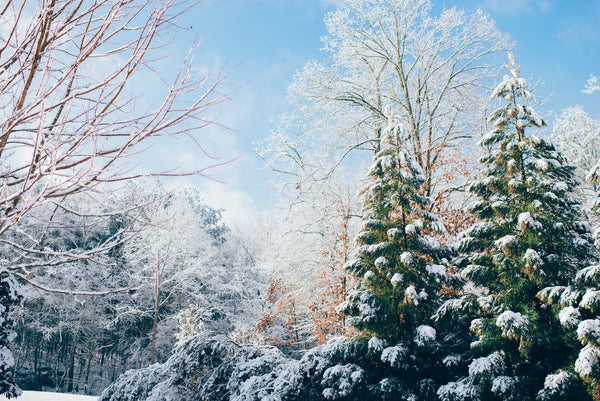
How Fast Do Evergreen Trees Grow?
Furthermore, you should consider how tall you want the trees to be in your yard. Make sure to anticipate the size of the trees once they mature. A tree’s growth rate will also have a bearing on your choices. Are you okay with a slow-growing tree, or do you need something that will establish height quickly? If shade or privacy screening is important, you may want to choose a fast-growing tree. Many evergreen trees can reach mature heights of 20 to 60 feet, whereas some dwarf varieties of evergreens only reach heights of 4 to 6 feet.
In order to choose your evergreen trees wisely, keep in mind the actual size of your yard and the allotted space for these trees. It's important to fit trees to their surroundings. Some evergreens will not look as attractive if they outgrow the area you’ve chosen for them. When a tree grows too large for its space, it may require regular pruning or removal.
We recommend using small to medium-sized varieties for smaller homes and yards. You can place smaller trees near your home and taller trees farther out in your landscape.
Cypress Trees
Cypress trees will make excellent additions to your landscape. They can be recognized by their pyramidal shape, small, rounded, woody cones, shoots and scale-like leaves. Their foliage can range from yellowish green to green or a grayish color. They can reach mature heights of up to 60 feet. Cypress trees can be grown in zones 4 to 11. In order to grow, they require full to partial sunlight.
Popular Cypress Trees:
- Leyland Cypress: Zones 6-10; 40-60 ft. tall by 20-25 ft. wide
- Italian Cypress: Zones 8-10; 35-40 ft. tall by 5 ft. wide
Planting: We recommend planting your cypress trees 10 to 12 feet apart from each other, unless you're planting a hedge. When creating a hedge, plant the trees 5 to 6 feet apart. Water your trees regularly and keep the soil moist at all times, but not soggy. You can fertilize your trees if you choose, but they don't require fertilization. If you choose to fertilize, use a balanced tree and shrub fertilizer.

Cypress Diseases
Cercospora Needle Blight: This is a fungus caused by cercospora sequoia, most common on Leyland Cypresses. However, it can affect other species of cypresses like Thujas, and Junipers. This causes browning of the needles on the lower part of the tree next to the stem. The infection eventually spreads upward and outward until only the needles on the tips of the branches are green. You can recognize this disease by the green pustules on the surface of the needles. This will spread mostly during the spring and summer by the wind. You can treat these trees by spraying them with a copper-based fungicide. Continue spraying the tree until new growth pushes out.
Seiridium Canker: This canker is one of the most damaging diseases to Cypress Trees. The canker can form on the stem or the branches, causing them to die back. They appear as brown or purple patches on the bark with resin coming out of them. Eventually the twigs and branches will turn bright red and then brown before dying. There's no chemicals that can be used to treat this at the time. You can avoid spreading the disease by keeping the tree from getting wounded and pruning off any infected branches or twigs. Also, sterilize your pruning tools in bleach prior to prevent rusting.
Botryosphaeria Canker: Similar to the Seiridium Canker, this fungus can cause reddish brown twigs and branches. The cankers that develop on the tree from this disease don’t have resin coming out of them. These cankers will not harm the trunk but will kill off the branches. The Botryosphaeria will attack trees that are under a lot of stress. In order to prevent this disease from attacking your trees, it's best to maintain good health for your tree. Mulching, and providing a good amount of water to your trees during extreme heat and drought will help.
Spruce Trees
Spruces are pyramidal trees than can be recognized by their stylish cone-like form and whorled branches. The needles on these trees are attached to the branches in a spiral-like formation. Spruce trees can range from 5 feet tall for dwarf trees to heights of 60 feet or taller for larger trees. These trees are usually grown as Christmas Trees, especially the Blue Spruce and Norway Spruce varieties. They require full to partial sun in order to thrive.
Popular Spruce Trees:
• Alberta Spruce (Canadian Spruce): Zones 2-8; 6-8 ft. tall by 4-5 ft. wide
• Norway Spruce: Zones 2-7; 50 ft. tall by 25 ft. wide
Planting: Plant spruce trees 20 to 25 feet apart. Make sure that you water your trees regularly in order to maintain moist soil. These evergreens don't need much fertilizer just plenty of sunshine and water. However, if you choose to fertilize these trees, you can use a tablespoon of balanced tree fertilizer and sprinkle it on top of the ground around each tree.
Spruce Tree Diseases
Spruce Needle Rust: This infection can cause your needles to become discolored, while the bugs remain green and alive. You'll notice the needles will drop off the next year. This can eventually cause the whole tree to turn a tan-pinkish color. This infection isn't treatable, and depending on how serious the infection is, the tree may not survive.
Spruce Spider Mites: These insects can cause the needles and branches to look like they’re dried up. If you use a magnifying glass you'll notice mites and eggs on the twigs. There will also be webs on the twigs. You can use a miticide to treat your tree. You can also treat your tree in June and July to prevent mites from getting on your trees in general.
Common Needle Cast: Older infected needles turn a tan color as a result of this fungus. Normally, the tree naturally sheds most of its needles. However, the infection causes them to fall off prematurely. When you take a closer look at the needles, you'll notice black fruiting bodies on the bottom of the needles. To prevent this, you can apply a single application of fungicide at the beginning of summer.
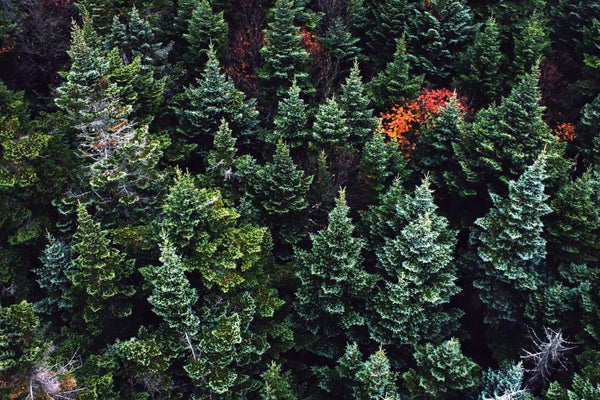
Cryptomeria Trees
These trees are known for their handsome cone-like shape and rich, reddish brown bark which often peels off in strips. These large trees can reach heights of 35 to 45 feet. They also have needle-like leaves that form spirally scales on their branches. These trees grow best in zones 5 to 9, and require full to partial sunlight.
Popular Cryptomeria Trees:
- Cryptomeria Radicans: Zones 5-9; 30-40 ft. tall by 15-20 ft. wide
- Cryptomeria 'Globosa Nana' Shrub: Zones 5-9; 4-6 ft. tall by 5-6 ft. wide
Planting: The best way to plant Cryptomeria trees is to space them about 15 to 20 feet apart from each other for the larger varieties. For the dwarf varieties, we recommend spacing them 2 to 6 feet apart from each other.
Cryptomeria Diseases
It is uncommon for these trees to have issues with diseases or pests. However, it’s always a good idea to keep an eye on your trees, and look for any signs of health issues.

Thuja Trees
Thujas are commonly known as arborvitaes and make wonderful landscape trees. The textured, reddish-brown wood on these evergreens is soft and aromatic. And the shoots on these trees come out on a single plane and are flat, with long, needle-like leaves. The leaves are arranged in crisscrossed pairs in four rows along the branches. Certain species of the Thuja have thicker foliage and larger cones. Thujas are very hardy and adapt to a variety of soil types and weather conditions and can range from heights of 10 feet for dwarf trees to 50 feet for the giants.
Thuja trees are extensively used for hedges and borders, as well as privacy screens and wind breaks. Their slender shape makes them a popular evergreen in landscape designs of all kinds.
Popular Thuja Trees:
• Thuja Green Giant: Zones 5-8; 30-50 ft. tall by 12-15 ft. wide
• Thuja Emerald Green: Zones 3-8; 10-15 ft. tall by 3-4 ft. wide
Planting: We recommend planting your Thuja trees 8 to 10 feet apart to achieve a taller height closer to 50 ft. If you have a small yard or want the height to be around 30 ft. or less, the trees can be planted 5 to 6 feet apart to form a hedge. Even though these trees are drought tolerant, it’s best to try and keep the soil moist around your trees. Keep in mind the tree’s growth is slowed during periods of drought. Thujas don't generally need fertilizer. You can fertilize in the early spring and early fall with Espoma Holly Tone or a general evergreen tree fertilizer.
Thuja Diseases
Tip Blight: This is a fungus that attacks weak or damaged areas on the Thuja. The infected needles on the tree begin to die and then eventually spread to the branches. The color of the leaves also turns from green to yellow, and before dying, they turn brown. You can prevent this disease from spreading by pruning off infected parts and using a fungicide.
Leaf Blight: This fungus attacks the leaves on arborvitaes and can be recognized by the dark brown to black circles on new leaves during the spring. Eventually the leaves turn brown and by fall, all the leaves on the tree will drop off. You can prevent leaf blight with a copper spray application in the summer and early fall.
Juniper Blight: Commonly affects red cedars and juniper trees. However, this disease can also attack Thuja Trees. The disease causes the branches to die back. Dieback will start at the tips of the shoots on young trees. If this isn't treated, the tree will eventually die. You can use fungicides containing copper and propiconzole.
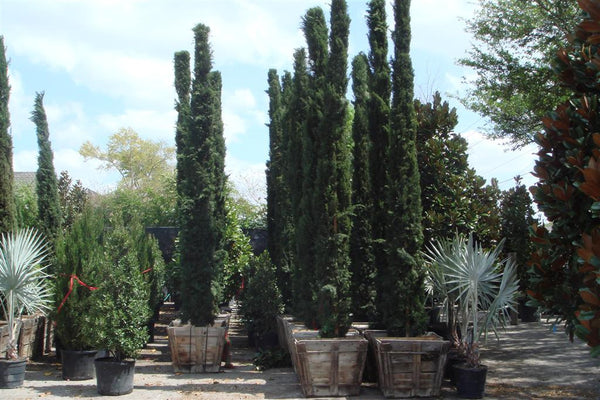
Holly Trees
Hollies are evergreens that are best distinguished by their glossy foliage. The leaves are typically saw-toothed, or indented on the ends. Depending on the species, some hollies are deciduous, and some push out flowers and/or berries. The berries ripen in winter and provide a nice red color contrast to your landscape. However, the fruit is not edible and should not be ingested, though they are good food sources for wildlife.
Similar to Spruce Trees, Hollies have become associated with the Christmas season. Varieties like the Nellie Stevens and American Holly are used as ornamental parts of the landscape during the holidays. Hollies are relatively slow growing evergreens. Though they can reach heights of 15 to 25 feet depending on the variety.
Popular Holly Trees:
• Nellie Stevens Holly: Zones 6-9; 15-25 ft. tall by 5-10 ft. wide
• American Holly: Zones 5-9; 20-50 ft. tall by 10-20 ft. wide
Planting: Space your Holly Trees 5 to 25 feet apart, depending on the variety and the mature size of the plant. Hollies prefer full to partial sun and moist, well-drained, acidic soil. You can use compost as fertilizer for these trees in the spring. It's recommended to spread it around the outer most branches, and then add 2 inches of mulch to help the tree retain moisture.
Holly Diseases
Canker: This disease causes sunken areas on the stems called cankers that eventually cause the tree to die. In order to save the trees, it's recommended that you prune off any infected branches.
Tar Spot: Infection can occur during the spring when temperatures are moist and cool. It starts off as yellow spots on the leaves, and they eventually turn brown to black in color. As a result, the leaves either develop holes or fall off. It's best to remove any infected leaves before the infection spreads throughout the tree.
Chlorosis: Another infection that can affect Hollies is Chlorosis, which is an iron deficiency and can lead to the disease. It causes light green to yellow leaves with dark green veins. It's best to reduce the pH levels in your soil or treat it with supplemental iron-fortified fertilizer.
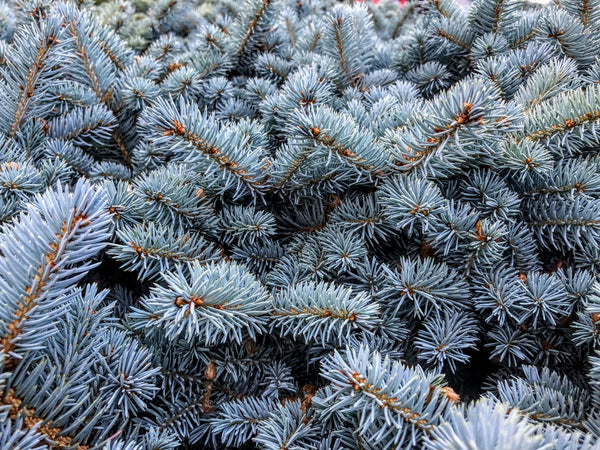
Juniper Trees
Juniper trees are lush evergreens with scale or needle-like leaves. These drought tolerant evergreens are also called cedars, though they're not actually cedar trees. These trees are species of the Juniperus in the Cupressacea family. Depending on the variety, Juniper trees can average heights of 15 to 20 feet.
Juniper trees can be planted almost anywhere, with one exception. We don't recommend planting them in your yard if there's apple trees in your yard or nearby. Apple trees sometimes become infected with cedar-apple rust. This fungus can easily transfer onto juniper trees and cause severe damaged to the tree.
Popular Juniper Trees:
• Spartan Juniper: Zones 5-9; 15-20 ft. tall by 4-5 ft. wide
• Hollywood Juniper: Zones 5-9 15 ft. tall by 10 ft. wide
Planting: We recommend planting junipers 3 to 6 feet apart, depending on whether you’re planting a tree versus a shrub. Shrubs are okay to be planted 2 to 3 feet apart if you’re using them as a hedge. Water your junipers deeply after planting, and then water them two times a week for a month following planting. After that, only water once a week except during extreme heat temperatures or drought. You can fertilize your junipers once a year in the spring with a slow release fertilizer. Spread fertilizer around your tree before watering the tree or before it rains.
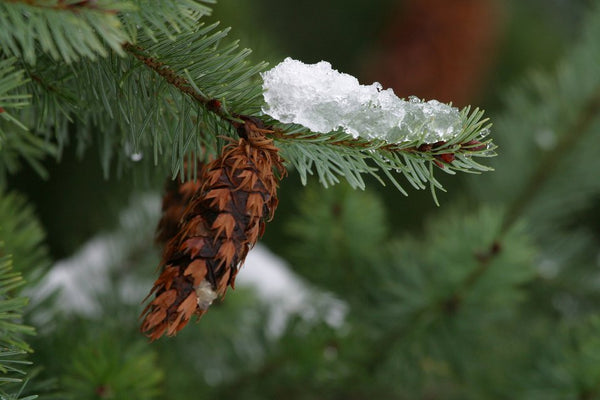
Location
Once you decide on your evergreen trees, it's also recommended that you plant them at least 10 to 15 feet from your home’s foundation and at least 5 feet from fencing, sidewalks, and patios. Keep in mind only short trees can be planted underneath utility lines. So, where should you plant your evergreen trees?
Property Lines
Evergreen trees are often used for screening near property lines, but it’s best not to put too many trees along your property line. This will help prevent overcrowding as the trees grow. A grouping of two evergreens is usually ideal in one or two key areas of your property line, as this will still help you gain the privacy you're looking for.
Patios or Decks
Adding evergreen trees to this area can provide shade from the sun and privacy from your neighbors. We recommend placing the trees 5 to 7 feet from the deck or patio. Place the evergreen trees on the side of your patio or deck where you could use the most privacy.
Open Backyard Space
An open space in your backyard will give you the most opportunity when it comes to planting evergreen trees. The number of trees you plant here depends on the size of your yard. It's best to plant evergreen trees where you need privacy or shade. You may not want to plant an evergreen directly over a garden or area that needs direct sunlight.
Parkways
It is not recommended to plant evergreen trees near a parkway. These trees make it difficult for cars to see while backing out of the driveway. It also makes it difficult to see the front of homes.
Open Front Yard Space
Your front yard is a good place to plant evergreen trees. Most front yards have room for at least two or three trees. It's suggested to place the trees randomly in the open space. Make sure to keep in mind the view of the areas around the home where flowers and bushes are growing. Your trees should be positioned a good 10 to 15 feet from the home.
Side Yard
Depending on the size of your lot, side yard spacing can also be an ideal spot for evergreen trees. Windbreaks and privacy screens can help frame your property. This can also help provide shade for your home and keep it cool during the summer months.
When to Plant Evergreen Trees?
Depending on your local climate, both spring and fall can be ideal for planting evergreen trees. Planting evergreen trees during the spring gives their root systems time to develop during the growing season. However, if you reside in an area that experiences severe heat and dry weather, it may be best to wait until fall to plant. Young evergreens are susceptible to heat and drought damage.
The benefit to planting in the fall is that the roots of evergreen trees grow more aggressively than when planted during the spring. The soil conditions are more ideal due to the amount of moisture in the air. However, if you decide to plant during the fall, it's best to do so prior to November. If your evergreen is planted too late, it could possibly suffer winter damage.
As you can see, there's a huge variety of evergreens to choose from, depending on your needs and preferences. And if you follow the proper planting and care instructions, your evergreen trees and shrubs can thrive for years to come. Perfect for providing a great deal of landscape solutions and adding texture and year-round beauty, even in the winter months when most other plants are dull and bare, evergreens are a reliable and rewarding landscape option.
For more inspiration, shop our entire collection of evergreens!
